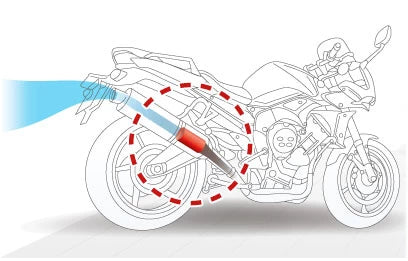Original Article here from Motociclismo magazine
https://www.motociclismo.it/omologazione-euro-5-plus-nuove-regole-cosa-cambia-81819
Euro 5+: the new rules
The work of the electronics is very complex: in high-end motorbikes it manages the ride by wire and all the multiple functions it makes possible. But the ECU carries out other very demanding activities, which we do not notice: in particular it checks compliance with Euro 5 emissions. And with Euro 5+ this task becomes even more complicated. Let's see what changes
Euro 5+ coming soon
The Euro 5 standard came into force in 2021, and for companies it was quite challenging: as we know, some engines were early retired because it was not technically possible, or economically convenient, to modify them to fit within the new limits. And it's not just a question of engines: Euro 5 includes a set of stringent standards to be respected both on polluting emissions and on control systems : the homologation process begins by carrying out the tests defined by the standard and ends with a technical report that must be sent, and therefore approved, by the competent authorities, i.e. the transport departments of the various European Ministries; the controls are very strict.
Now Euro 5+ is arriving, mandatory from 2024 for all newly homologated vehicles, and from 2025 for new registrations of models already in the range. There are no significant changes, but things are getting even more difficult for companies: it will not be enough to pass the tests for the new emission limits, but it will be necessary to satisfy some new, more stringent directives linked to on-board diagnostics, durability tests and to noise (this aspect is still being defined).
Before analyzing the new features of Euro 5+, let's look at the starting point: Euro 5. Which, as we anticipated, is already quite challenging for companies to satisfy. To have a technical point of view, and to understand what it means for a motorcycle manufacturer to move from Euro 5 to Euro 5+, we made use of the consultancy of Dell'Orto, which offers two "specialized" control units specifically to satisfy the new European Directives . At the headquarters of the Italian company we met engineer Paolo Colombo, Head of the Research, Development and Innovation Laboratories, who illustrated the situation very clearly to us: once upon a time the control units had to think about managing the ignition and, at most, the 'injection; today they do a considerable amount of work, which we don't notice. Let's see what they're hiding...

The directives of the current Euro 5
As anticipated, the advent of Euro 5 has significantly challenged motorcycle manufacturers, imposing rather stringent limits not only on emissions but also on control systems, which must be much more sophisticated than those required by Euro 4. Let's see what the directives say now in force.
Emissions limits . Euro 5 introduced very strict limits on emissions, similar to Euro 6 for cars, in particular the emissions of nitrogen oxides and unburned hydrocarbons were reduced. It even starts upstream of the engine, from the tank, which must not have a free vent; for this reason, an activated carbon trap is used which must be periodically purged, unless the system mounted on the motorbike is equipped with a valve that discharges the vapors into the intake duct, so that they end up in the combustion chamber to be burned together with the fuel mixture; the emission limits are so low that the vapors coming from the tank would be higher than those from the exhaust.
Durability of anti-pollution devices, catalyst . Euro 5 provides three options: carry out a test covering a certain amount of kilometers (for motorbikes with a maximum speed over 130 km/h the accumulation is 35,000 km); travel half of it, measure the efficiency of the catalyst and calculate the projection at 35,000 km; or evaluate the decay at the table using a deterioration factor (a method that all manufacturers currently use).
CO2 emission . The rule is unchanged compared to Euro 4, there are no limits but emissions must be measured and declared in mg/km (for example for possible higher taxes or concessions).
OBD (On Board Diagnostic ). An important innovation introduced by Euro 5 is linked to OBD (On Board Diagnostics). Euro 4 included OBD I, a diagnostic that simply checks whether a sensor is connected, short-circuited or disconnected; in these last two cases the fault had to be reported by turning on the orange MIL (Malfunction Indicator Lamp) on the dashboard. Euro 5 has imposed OBD II, which also carries out a check on the coherence of the data read by the sensor, i.e. it verifies that it behaves correctly (we talk about "rationality" indices).
Check for misfires . The most important innovation introduced by Euro 5 is the misfire function: that is, the system's ability to recognize misfires. This check is necessary because if there is no ignition, for example due to a dirty spark plug, the engine emits unburned hydrocarbons. Dellorto has implemented a system in the control unit that recognizes even a single misfire, and does so by monitoring the motion of the crankshaft, without using additional sensors. In normal conditions when there is combustion the crankshaft accelerates; when it closes the throttle decelerates. If there is no ignition, it decelerates, and the system is so sensitive as to detect the single event, and for this reason it must be perfectly calibrated to avoid false positives. The legislation says that misfires must be recognized and intervened before they cause certain limits to be exceeded, so there is a certain margin. Is this an important check? In Europe, with modern engines, high quality petrol and spark plugs, misfire can be said to be a rare phenomenon; however, it may be different in emerging countries, where the petrol is less refined and sometimes mixed with low-cost agricultural oil, and in this case the spark plug may suffer.
Deterioration of the lambda probe . The Euro 4 required the same control as the other probes, i.e. whether connected or short-circuited; Euro 5 imposed the monitoring of the response, which must fall within a defined limit.

What changes with the Euro 5+
Since we are talking about 5+, you can imagine that this new "version" of Euro 5 is an update of the current ones, and in fact it is. In fact, the limits on emissions do not change, we are waiting for the decision on noise measures, but there are however some rather important constraints, therefore challenging for motorcycle companies. Let's start from the most onerous, the evaluation of durability.
Removing the math calculation option via deterioration factor . It is no longer possible to use a mathematical formula to evaluate the level of pollutants emitted after a certain mileage (which depends on the category of the vehicle), and it is therefore necessary to carry out the mileage accumulation test by carrying out a predefined cycle, for example using a robotic bench, with accelerator controlled by a program, or on the track. The kilometers to accumulate depend on the category of the vehicle, for medium and high performance motorbikes they are 35,000. There are two types of tests: complete or partial accumulation, up to 50% (therefore minimum 17,500 km) then the data is measured and a projection is made. It is easy to predict that everyone will follow this second test, which is still quite demanding and adds an additional cost to companies. For the majority of today's vehicles this test does not involve difficulties, other than those related to costs and times of mileage accumulation, because today's engines are designed and tested to guarantee the efficiency of the anti-pollution systems over time. However, this procedure could skim off the remaining fringes of injection systems or poor quality catalysts, which have passed the first stage of the Euro 5 by the skin of their teeth.
OBD II level update . In addition to the previously specified checks on the consistency of sensor data, which have also been revised within tolerance limits, there are catalyst monitoring and the imposition of minimum limits on the frequency of monitoring via the IUPR (In-Use Performance Ratio). It is an indicator, calculated by the control unit, which measures how many times the system has monitored (the catalytic converter, the probes, etc.) during the use of the vehicle. This limit is set at 10%, i.e. the on-board diagnostics must come into operation at least once in ten that the vehicle is used. Monitoring of the catalytic converter is carried out with a second lambda sensor, which itself must be diagnosed. If the catalyst works well, and therefore compensates for the lean and fattier phases by offering a regular signal, the downstream probe will also provide a regular signal; vice versa, if the control probe detects an irregular trend it means that the catalyst has a malfunction. The downstream probe can be positioned after the catalyst; in systems that have more than one you can choose whether to place it after the first or at the end, and each manufacturer decides where to insert it, generally trying to hide it so as not to ruin the aesthetics. From this point of view, Triumph should be mentioned, which on the classic models did an excellent job of hiding the control probe in a finned ring on the exhausts, which is practically invisible. How useful is catalyst monitoring from a technical point of view? There are two causes of damage to catalysts: chemical and physical. The first is due to the use of low quality fuel, or to significant oil leaks from the exhaust pipe. In Europe, with our petrol and modern engines, this problem is almost irrelevant. The other, more important cause is heat: for example, if a catalyst works at a high temperature (950-1,050 °C instead of 400-800) for a long time, the exchange surfaces can be damaged, which lose porosity, and the catalyst becomes less effective; this is also a limit situation that rarely occurs in reality.
Mandatory OBD monitoring while driving . The system must signal the operating modes that lead to a significant reduction in engine torque (the same check must be performed on electric vehicles). A situation which, for example, can occur due to overheating which requires the vehicle to be driven at reduced rpm and loads: this must be reported to warn the driver that he cannot count on the full power of the engine.

Reasoned alarms
Generally everything regarding emissions is strictly established, but there are some choices that are left to the discretion of the Manufacturer. For example, in some cases you can decide to turn on the malfunction light of a sensor only after receiving the error signal three times. Or don't turn it on if after three error signals the sensor starts working normally again: in this case there is no point in worrying and forcing the owner of the motorbike to go to the workshop to carry out a now useless check. However, electronics allow you not to miss anything. In fact, it can store all the events in the control unit (how many times they occurred, how long they lasted, under what conditions they occurred), and this is a great advantage for a subsequent check, when diagnostics are carried out in the workshop.

